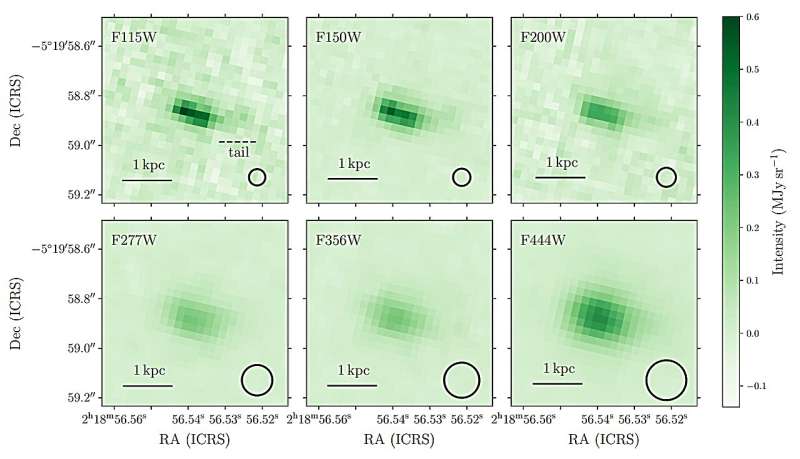An international team of astronomers has utilized the James Webb Space Telescope (JWST) to investigate a distant galaxy known as SXDF-NB1006-2. This research reveals that the galaxy is a young starburst galaxy characterized by significant ionized gas outflows. The findings were published on October 29, 2025, on the arXiv preprint server, providing new insights into the early universe.
Discovered in 2011, SXDF-NB1006-2 is located approximately 12.9 billion light years away from Earth, making it one of the most distant galaxies known. Prior observations had indicated that it might be a young starburst galaxy with a remarkably short star formation period of about 1–2 million years. To delve deeper into its characteristics, a research team led by Yi W. Ren from Waseda University in Tokyo employed JWST’s advanced Near Infrared Camera (NIRCam) and Near Infrared Spectrograph (NIRSpec).
The researchers report that the ultraviolet continuum of SXDF-NB1006-2 displays an elongated, clumpy morphology resembling a tail-like structure, likely indicating an edge-on disk or a chain galaxy formation. Notably, the oxygen emission also appears clumpy, with a tail extending westward, suggesting that SXDF-NB1006-2 may have undergone merger events in its past.
The analysis revealed a broad component of the oxygen emission line, extending around 6,000 light years, indicative of prominent ionized gas outflows. The galaxy is dominated by young stellar populations and is currently in a bursty phase of star formation. This analysis suggests an estimated age of approximately two million years and indicates the presence of a powerful radiation field.
According to the study, SXDF-NB1006-2 has a star formation rate of around 38 solar masses per year, with a metallicity of about 0.2 solar metallicities. The gas mass of the galaxy has been calculated at approximately 19.3 billion solar masses, with a gas depletion time estimated at around 144 million years.
The authors conclude that SXDF-NB1006-2 may be quenched at a redshift between 6.5 and 5.0. This finding implies that this galaxy could be a progenitor of the massive quiescent galaxies observed at redshifts of around 4.0–5.0. As the astronomers explain, “The derived gas depletion time of a few hundred million years implies that our target could be one of the progenitors of massive quiescent galaxies at z ∼ 4−5 identified by recent JWST observations.”
This research contributes significantly to our understanding of galaxy formation and evolution in the early universe, leveraging the powerful capabilities of the JWST to explore the cosmos.
